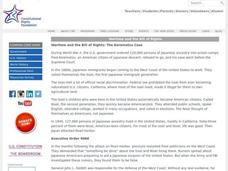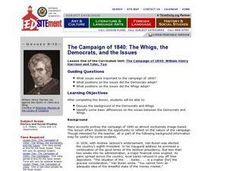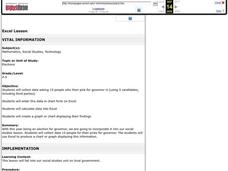Curated OER
Introduce Vocabulary: A Picture Book of Abe Lincoln
Young scholars examine SA Picture Book of Abe Lincoln. In this language arts lesson, students listen to the story and discuss the meaning of the story vocabulary.
Curated OER
Online Lesson Political Parties, Platforms, and Planks
Students explore historical political parties and their platforms. After studying the origins and functions of political parties, students create their own platform to address current issues. In groups, students design an ad campaign...
Curated OER
Good Citizen Posters
Third graders create a poster documenting the responsibilities of a good citizen. During group discussion, they develop a list of ways in which they can participate as responsible citizens in their society. Students use their list to...
Curated OER
A Life in Politics
Students answer a quiz about congressional leaders. They research former majority leaders and create charts about them. They write letters to the current majority leader about a current issue.
Curated OER
Campaign Posters 1788-1816
Seventh graders examine the first years of the U.S. under the U.S. Constitution. They identify the main themes of the Federalist and Republican parties, conduct research, and write a campaign speech and create a campaign poster.
Curated OER
Wartime and the Bill of Rights: The Korematsu Case
Students examine the balance between civil liberties and protection. For this national security lesson, students explore the Korematsu case which references the Japanese internment camps of World War II. Students draw comparisons between...
National Constitution Center
Address America: Your Six-Word Stump Speech
Stump speeches are the focus of this exercise that combines politics and language arts. After learning about this type of speech, the class listens to Obama's 2008 presidential campaign stump speech and answers a series of questions that...
Curated OER
The Campaign of 1840: The Campaign
Learners discuss the use of visual images, objects, and spectacle in the 1840 campaign, then take a stand: Was the campaign of 1840 based more on substance or image?
Curated OER
The Campaign of 1840: The Candidates
Students compare and contrast William Henry Harrison and Martin Van Buren as candidates for president. They explain why the Whigs wanted to find a candidate in the mold of former president Andrew Jackson and discuss whether Harrison fit...
Curated OER
The Campaign of 1840: The Whigs, the Democrats, and the Issues
Students reflect on the nature of the campaign of 1840. They identify the positions of the Democrats and the Whigs and their basic differences.
Curated OER
Lincoln Goes to War
Students examine the secession crisis of 1861 and the significance of the Confederate attack on Fort Sumter. They read and analyze Lincoln's First Inaugural Address, conduct research, and write an executive memorandum.
Curated OER
Woman Suffrage in Colorado, 1877-1893
Students work together in groups to examine the suffrage movement in Colorado. They analyze the reasons for and against women's suffrage. They also determine the impact of the movement in Colorado.
Curated OER
Excel Lesson
Students explore data and Excel spreadsheets. They collect data about political candidates. Students enter the data into a chart on Excel. They create a graph using the data and Excel.
Curated OER
Voters and Judges
Students analyze the work on independent judiciaries. In this federal courts lesson, students listen to their instructor lecture on details of federal cases. Students respond to discussion questions and participate in an activity...
Curated OER
The First Day of Congress
Students examine experiences had by representatives on the first day of Congress. They role-play the role of one of the members of Congress and they participate in opening day events. They complete worksheets to finish the lesson plan.
Foreign Policy Research Institute
Understanding China: The Prospects for Democracy in China
This document provides useful information for a unit on democracy in China. While it does not include detailed activities, it does have a list of democratic principles, and important facts about China that facilitate understanding of its...
Curated OER
Technology and the Media
Students are introduced to the roles and influence of technology and the media on American representative democracy. They examine the effects of the Internet on citizens' role in government and the role and effects of media on the...
Curated OER
Homemade Political Parties
Use this 5-day lesson to clarify the platforms of the two major parties, comparing and contrasting against students' beliefs. Begin by looking at unlabeled summaries of both party platforms, having learners identify most with one. Groups...
Curated OER
Design a State Seal
Fourth graders examine the meanings of symbols on the Ohio state Seal. They create their own personal seals which include three items about themselves. They write explanations about their seals.
Curated OER
Rational Equations and Proportions
In this rational equations worksheet, students solve and complete 11 various types of problems. First, they find a number that is the reciprocal of one described in each statement. Then, students solve for the variable in each expression.
Curated OER
Newspaper Fact Treasure Hunt
Students explore the newspaper. In this research lesson, students search for answers within the newspaper. Students collaborate with classmates to find the answers.
Curated OER
Navigating the Road to the White House
Students explore U.S. politics by researching the Presidential requirements. In this electoral process lesson, students identify the main requirements to become a Presidential candidate and the two main political parties. Students...
Curated OER
A More Perfect Union: Women's Suffrage and the Constitution
Young scholars reflect on the pros and cons of Women's Suffrage and it was viewed during the late 1800's. In this history lesson, students will analyze documents on women's suffrage so that they can compare and contrast the rights of...
Curated OER
A Conservative Era
In this Conservative Era worksheet, young scholars write definitions for six terms, examine five pairs of sentences then determine which one is false, then link two sets of words together by identifying which historical theme they share...

























